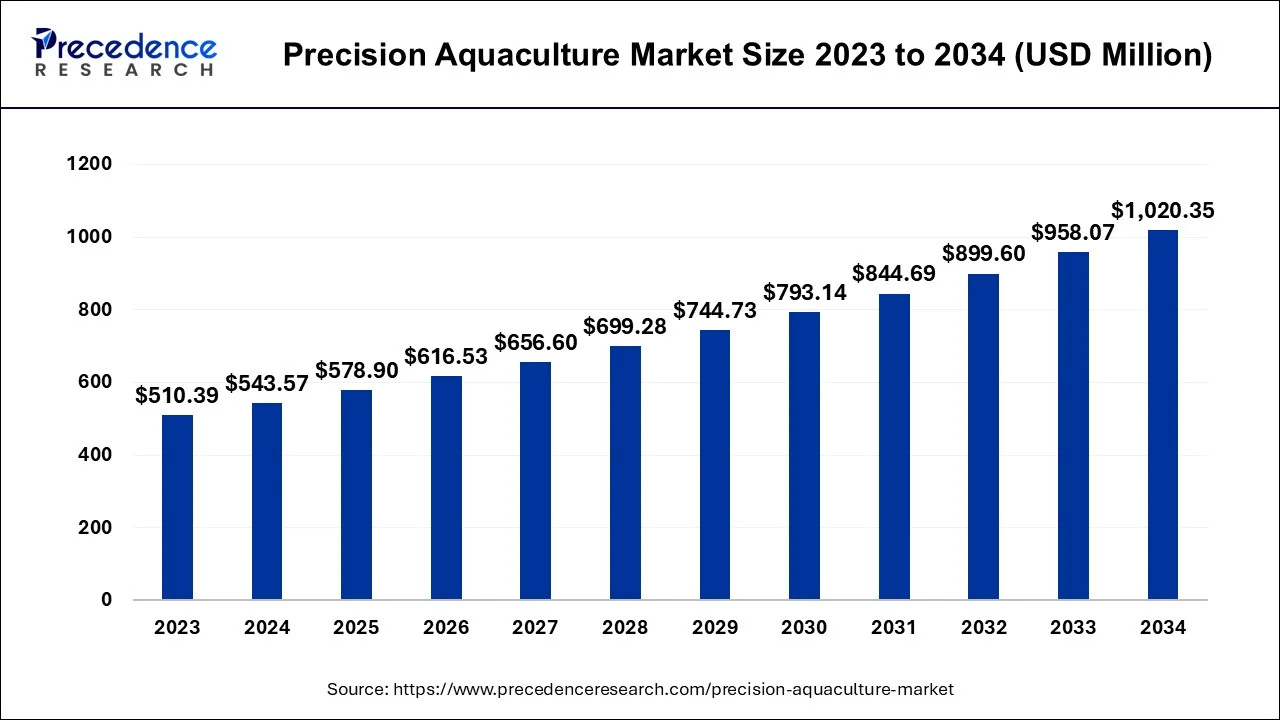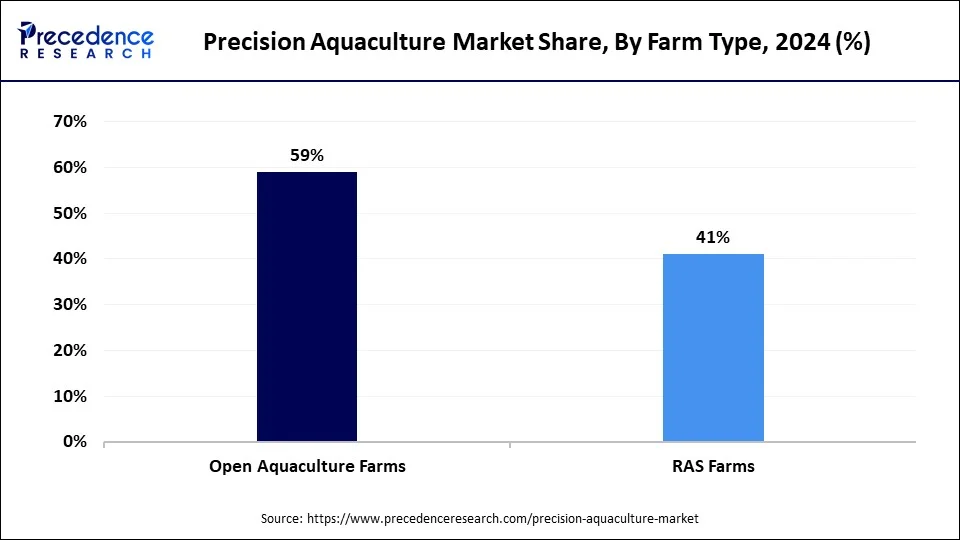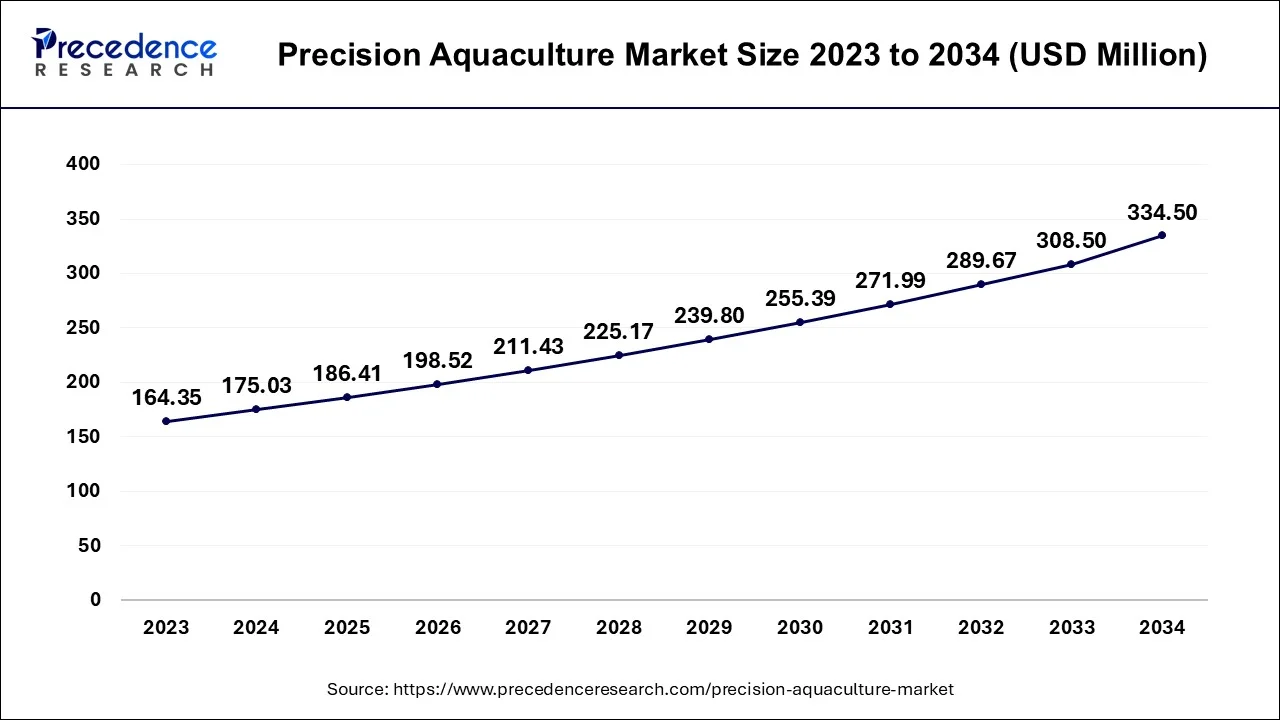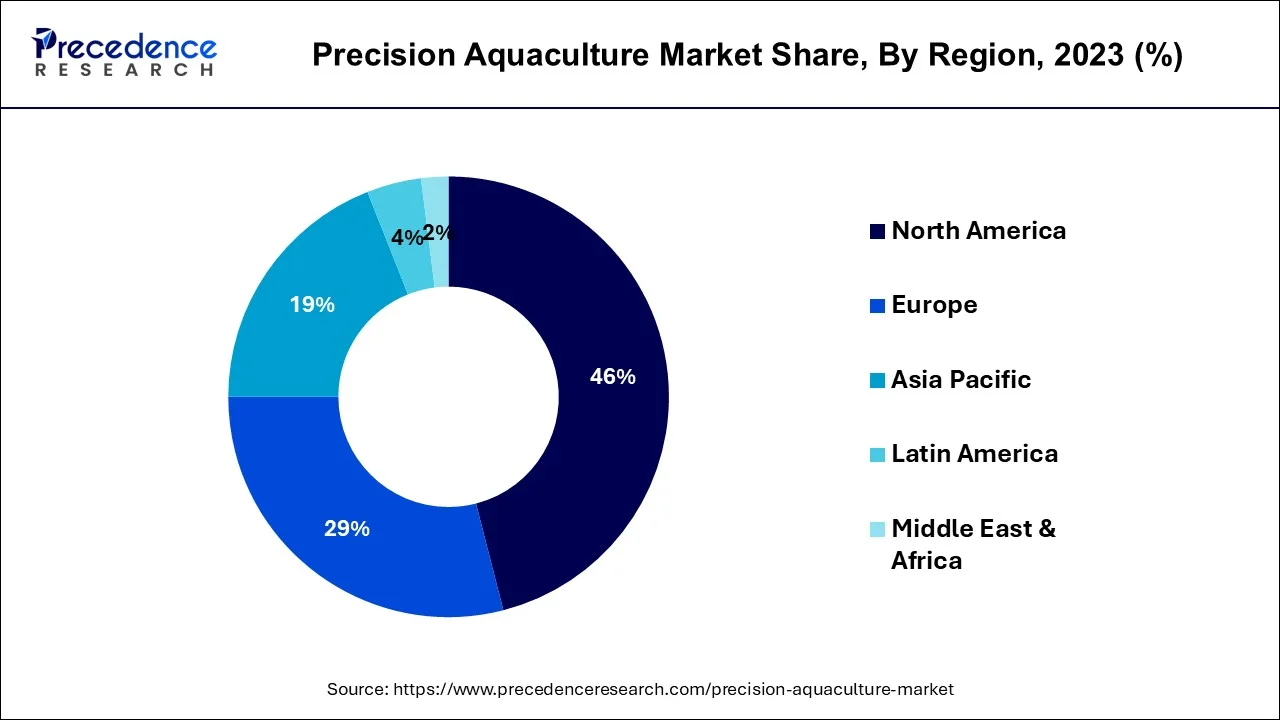What is the Precision Aquaculture Market Size?
The global precision aquaculture market size ie estimated at USD 578.90 million in 2025 and is anticipated to reach around USD 1,020.35 million by 2034, growing at a CAGR of 6.50% between 2025 and 2034.

Market Highlights
- North America contributed more than 46% of revenue share in 2025.
- Asia Pacific is estimated to expand the fastest CAGR between 2023 and 2034.
- By Offering, the hardware segment has held the largest market share of 61% in 2025.
- By Offering, the service segment is anticipated to grow at a remarkable CAGR of 10.2% between 2025 and 2034.
- By Application, the monitoring & surveillance segment generated over 34% of revenue share in 2025.
- By Application, the feed optimization segment is expected to expand at the fastest CAGR over the projected period.
- By System Type, the monitoring & control system segment had the largest market share of 50% in 2025.
- By System Type, the smart feeding system segment is expected to expand at the fastest CAGR over the projected period.
- By Farm Type, the open aquaculture farm segment generated over 59% of revenue share in 2025.
- By Farm Type, the RAS farm segment is expected to expand at the fastest CAGR over the projected period.
Market Size and Forecast
- Market Size in 2025: USD 578.90 Billion
- Market Size in 2026: USD 578.9 Billion
- Forecasted Market Size by 2034: USD 1,020.35 Billion
- CAGR (2025-2034): 6.50%
- Largest Market in 2024: North America
- Fastest Growing Market: Asia Pacific
Market Overview
The precisionaquaculture marketrefers to the application of advanced technologies and data-driven techniques for the precise management and monitoring of aquatic farming, with a primary focus on fish and shrimp. It encompasses the use ofInternet of Things(IoT),artificial intelligence(AI), sensors, and automated systems to optimize feeding, water quality, disease management, and overall farm operations.
Precision aquaculture aims to enhance production efficiency, reduce environmental impacts, and ensure sustainableseafoodproduction, addressing the growing global demand for aquatic products while minimizing resource consumption and environmental degradation. This market plays a pivotal role in revolutionizing aquaculture practices, making them more data-centric, efficient, and environmentally responsible.
Precision Aquaculture Market Growth Factors
- The increasing global population and demand for high-quality seafood are driving the adoption of precision aquaculture for efficient and sustainable production.
- Precision aquaculture harnesses technological innovations like advanced sensors, automation, IoT integration, and data analytics. These tools empower aquaculture operations to fine-tune vital aspects such as water quality, feeding schedules, and disease management.
- A key focus of precision aquaculture is mitigating environmental impact. By closely monitoring and controlling aquaculture systems, waste is reduced, and environmental sustainability is prioritized.
- The adoption of IoT devices and sensors is gaining traction within aquaculture. These tools enable real-time monitoring and control of water conditions and the well-being of aquatic life, enhancing overall operational efficiency.
- The increasing use of data analytics and machine learning is revolutionizing aquaculture. Predictive modeling and data-driven decision-making are becoming integral to optimizing production and environmental stewardship.
Market Scope
| Report Coverage | Details |
| Market Size in 2025 | USD 578.90 Million |
| Market Size in 2026 | USD 616.53 Million |
| Market Size by 2034 | USD 1,020.35 Million |
| Growth Rate from 2024 to 2034 | CAGR of 6.50% |
| Largest Market | North America |
| Base Year | 2023 |
| Forecast Period | 2024 to 2034 |
| Segments Covered | Offering, Application, System Type, Farm Type, and Region |
| Regions Covered | North America, Europe, Asia-Pacific, Latin America, and Middle East & Africa |
Market Dynamics
Drivers
Technological advancements and IoT integration
Aquaculture has witnessed significant advancements in sensor technology, data analytics, automation, and remote monitoring. These innovations allow farmers to gain real-time insights into critical parameters such as water quality, temperature, oxygen levels, and fish behavior. This data-driven approach enables precise control over aquaculture systems, resulting in optimized feed management, healthier fish stocks, and reduced operational costs. It also contributes to the environmental sustainability of aquaculture operations by minimizing waste and resource usage.
The integration of IoT devices and sensors has revolutionized aquaculture management. IoT technologies enable continuous data collection and transmission, giving aqua culturists the ability to remotely monitor and adjust environmental conditions in real-time. This leads to early disease detection, better feeding strategies, and improved water quality management. Farmers can also respond promptly to any adverse changes, ensuring the well-being of their aquatic populations. The seamless connectivity and automation offered by IoT solutions streamline operations, enhancing productivity and sustainability in precision aquaculture.
Restraint
High initial investment and environmental impact
Precision aquaculture technologies often require substantial upfront investments. Implementing advanced systems like sensor networks, data analytics, and automation can be costly for both small-scale and large-scale aquaculture operators. High capital expenditure can act as a barrier, particularly for smaller players in the industry, limiting their ability to adopt these technologies. Additionally, the ongoing maintenance and operation costs can also be substantial. This financial burden can deter aquaculture businesses from embracing precision aquaculture solutions, slowing down the market's growth.
While precision aquaculture aims to reduce the environmental footprint of the industry, there are challenges related to energy consumption, waste management, and the release of chemicals into aquatic environments. Inefficient precision aquaculture systems can potentially harm local ecosystems and water quality. Ensuring that these technologies are genuinely sustainable and do not inadvertently damage the environment requires careful planning and investment, adding to the overall costs. Regulatory hurdles and concerns about ecological impact can restrict market growth, as aquaculture operators navigate the complexities of maintaining an environmentally responsible operation while using precision technology.
Opportunity
Sustainable seafood production and data-driven decision-making
Consumers, environmental organizations, and regulatory bodies are pressuring the aquaculture industry to adopt more responsible practices. Precision aquaculture addresses this demand by enabling farmers to optimize production, minimize resource use, and reduce environmental impacts. By closely monitoring and controlling key parameters like water quality, feed consumption, and fish health, aquaculture operations can produce seafood more sustainably.
The integration of data analytics and IoT technologies is transforming aquaculture into a data-rich industry. Precision aquaculture allows farms to gather real-time data on water conditions, fish behavior, and other critical factors. This data is then analyzed to make informed, data-driven decisions. Whether it's adjusting feeding schedules, identifying disease outbreaks early, or optimizing the use of resources, data-driven decision-making enhances productivity and profitability. This shift towards analytics-driven operations aligns with the broader trend of using technology to improve efficiency and sustainability in aquaculture, thus driving the demand for precision aquaculture solutions.
Segments Insights
Offering Insights
According to the offering, the Hardware has held a 61% revenue share in 2023. Hardware in the Precision Aquaculture Market includes advanced equipment such as water quality sensors, underwater drones, feeding systems, and environmental monitoring devices. These tools are crucial for data collection and control within aquaculture systems. The trend in precision aquaculture hardware is towards greater automation and miniaturization, allowing for real-time data collection and analysis.
The service segment is anticipated to expand at a significantly CAGR of 10.2% during the projected period. Services in this market encompass consulting, maintenance, and data analytics. Aquaculture operations are increasingly seeking expert advice and digital solutions to optimize their systems. The trend in precision aquaculture services is moving towards more data-driven decision-making and comprehensive farm management, leading to enhanced operational efficiency and sustainability.
Application Insights
Based on the application, the monitoring and surveillance segment is anticipated to hold the largest market share of 34% in 2025. In precision aquaculture, monitoring and surveillance systems have become indispensable. These technologies include underwater cameras, sensors, and drones that monitor fish health, water quality, and environmental conditions. They help aquaculture operators detect disease outbreaks, track fish behavior, and optimize growth conditions. The trend in this segment is towards more sophisticated and interconnected monitoring systems that provide real-time data and predictive analytics, enabling proactive interventions to enhance aquaculture productivity and fish welfare.
On the other hand, the feed optimization systems segment is projected to grow at the fastest rate over the projected period. Feed optimization systems use data analytics to tailor feeding strategies, minimizing waste while ensuring fish receive the right amount of nutrition. These systems analyze factors like fish size, environmental conditions, and growth rates to adjust feeding schedules. A trend in feed optimization is the incorporation of machine learning algorithms that continuously adapt and refine feeding plans. This enhances resource efficiency, reduces operational costs, and minimizes the environmental impact of aquaculture operations.
System Type Insights
In 2025, the monitoring & control system segment had the highest market share of 50% on the basis of the end user. The monitoring & control system in precision aquaculture involves the use of sensors, cameras, and other data collection tools to monitor water quality, fish behavior, and environmental conditions. This system also allows for real-time adjustments in water temperature, oxygen levels, and feeding schedules, ensuring optimal conditions for fish growth. A key trend in this area is the integration of advanced sensors and IoT technology for more precise monitoring and control, improving overall farm efficiency and reducing resource wastage.
The smart feeding systems segment is anticipated to expand at the fastest rate over the projected period. Smart feeding systems in precision aquaculture involve automated feed dispensers that optimize feeding schedules and quantities based on real-time data. These systems reduce overfeeding, minimize feed waste, and improve feed conversion ratios. The trend in this segment includes the integration of AI and machine learning algorithms to create data-driven feeding strategies, enabling precise and efficient feeding tailored to the specific needs of each fish in the aquaculture facility. This technology enhances sustainability by reducing feed waste and optimizing fish growth.
Farm Type Insights
In 2025, the open aquaculture farms segment had the highest market share of 59% on the basis of the end user. Open aquaculture farms refer to traditional aquaculture facilities where fish or other aquatic organisms are raised in open-water environments like ponds, lakes, or coastal areas. In precision aquaculture, there's a growing trend toward incorporating technology to monitor water quality, optimize feeding, and improve disease management. This involves the use of sensors and data analytics to enhance resource efficiency and minimize environmental impacts.

The recirculating aquaculture systems (RAS) segment is anticipated to expand at the fastest rate over the projected period. Recirculating Aquaculture Systems (RAS) Farms are enclosed systems where water is continuously filtered and recirculated, providing a controlled environment for aquatic species. Precision aquaculture trends in RAS farms include the integration of IoT sensors and automation to closely monitor and control water quality parameters, feeding schedules, and fish health. Data-driven decision-making is becoming central in RAS farms to optimize resource usage and boost production efficiency while maintaining sustainability.
Regional Insights
U.S. Precision Aquaculture Market Size and Growth 2025 to 2034
The U.S. precision aquaculture market size ie estimated at USD 186.41 million in 2025 and is expected to be worth around USD 334.50 million by 2034, at a CAGR of 6.69% from 2025 to 2034.

North America has held the largest revenue share 46% in 2025. North America leads in precision aquaculture adoption, driven by advanced technological infrastructure and growing environmental concerns. In the United States and Canada, aquaculture farms are leveraging automation, IoT sensors, and data analytics to optimize water quality, feed management, and disease control. Additionally, a focus on sustainability, with strong support for eco-friendly practices, fosters innovation and further adoption.

Asia Pacific is estimated to observe the fastest expansion. In the Asia-Pacific region witnesses rapid growth in precision aquaculture due to its significant presence in the global aquaculture industry. Countries like China and India lead in adopting advanced technologies to ensure efficient, sustainable, and high-yield aquaculture production. The increasing demand for seafood and environmental sustainability are key drivers propelling precision aquaculture's growth in the Asia-Pacific region.
Precision Aquaculture Market Companies
- AKVA Group
- Aquabyte
- Aquafine Corporation
- Aquaculture Systems Technologies (AST)
- Cermaq
- Cooke Aquaculture
- Deep Trekker Inc.
- In-Situ, Inc.
- InnovaSea Systems, Inc.
- Jala Tech
- Pentair Aquatic Eco-Systems
- Pioneer AQUA
- XpertSea
- Steinsvik
- Vaki
Recent Developments
- In 2021, Innovasea Systems launched the V3 acoustic telemetry transmitters, a groundbreaking addition to their fish tracking tag portfolio. These tags, among the smallest available, enable comprehensive research on smaller and younger fish species, offering scientists valuable insights into various stages of their lifecycles.
- In 2020, Bluegrove, along with its subsidiary CageEye AS, acquired SEALAB, an aquatech company. This strategic move aims to merge their sensor technologies and establish an open platform for seamless integration with other suppliers. Bluegrove's focus on shaping the Internet of Species (10S) is poised to drive innovation in aquaculture, agriculture, and forestry, potentially sparking an ecological revolution.
- In 2020,AKVA group has successfully acquired Newfoundland Aqua Service Ltd (NAS), a prominent provider of fish farming services in Newfoundland and Labrador. NAS specializes in manufacturing fish cages, docks, boats, barges, nets, and offers various services such as net washing, manufacturing, testing, repair, and antifoulant treatment. This strategic acquisition enhances AKVA group's footprint in the region.
Segments Covered in the Report
By Offering
- Hardware
- Software
- Service
By Application
- Feed Optimization
- Monitoring & Surveillance
- Yield analysis & Measurement
- Others
By System Type
- Smart Feeding System
- Monitoring & Control System
- Underwater Remotely Operated Vehicle System
- Others
By Farm Type
- Open Aquaculture Farm
- RAS Farm
By Region
- North America
- Europe
- Asia-Pacific
- Latin America
- Middle East and Africa
For inquiries regarding discounts, bulk purchases, or customization requests, please contact us at sales@precedenceresearch.com
Frequently Asked Questions
Ask For Sample
No cookie-cutter, only authentic analysis – take the 1st step to become a Precedence Research client
 sales@precedenceresearch.com
sales@precedenceresearch.com
 +1 804-441-9344
+1 804-441-9344